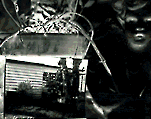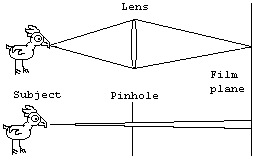


 Pinholes do not form images as sharp as those formed by a good glass lens. Also, they cannot be made to correct for chromatic aberrations (this means that if a color photograph is made with a pinhole camera, the colors will be somewhat out of line with each other. Simple lenses will do this as well.) A pinhole image is also dim, so longer exposures must be made.
Pinholes do not form images as sharp as those formed by a good glass lens. Also, they cannot be made to correct for chromatic aberrations (this means that if a color photograph is made with a pinhole camera, the colors will be somewhat out of line with each other. Simple lenses will do this as well.) A pinhole image is also dim, so longer exposures must be made.
Pinholes do have infinite depth of field. That is to say, although the resulting image is softly focused, all points in that image are equally in focus, from infinity to a few inches away. Since there is no curved glass surface, pinhole images are fee from spherical aberrations, meaning that a straight line will always appear straight. Also the soft image formed is usually considered an advantage by pinhole artisans.
To understand the difference in how a pinhole and a lens form an image, imagine one point on an object some distance away. Light is reflecting off of and spreading out from that point in all directions, and in effect is forming millions of overlapping images everywhere. A lens takes in all of the rays of light from that point which enter into it and bends them, focusing them back down to a point on the film plane.
 A pinhole does not focus an image. It acts more as a filter. It limits the light which reaches the film to a single path for each subject point. The paths are straight lines, so the image is inverted top to bottom and left to right (trace a straight line from the chicken's foot through the pinhole and it winds up at the top of the film). Ideally, a pinhole would be so small as to let in only one wave of light for each subject point. This would be true if not for the wave properties of light, which cause the light to diffract and the image to deteriorate as very tiny pinhole sizes are approached Therefor, each object point is seen by the pinhole as a bundle of waves, which spread out from the object to the pinhole to the image plane (film) as a cone. This cone creates a circle of light on the image plane, instead of a sharp point like a lens forms. This circle determines how sharp the image is, both in its size and in how greatly it overlaps its neighbors (more on this in the optimization page).
A pinhole does not focus an image. It acts more as a filter. It limits the light which reaches the film to a single path for each subject point. The paths are straight lines, so the image is inverted top to bottom and left to right (trace a straight line from the chicken's foot through the pinhole and it winds up at the top of the film). Ideally, a pinhole would be so small as to let in only one wave of light for each subject point. This would be true if not for the wave properties of light, which cause the light to diffract and the image to deteriorate as very tiny pinhole sizes are approached Therefor, each object point is seen by the pinhole as a bundle of waves, which spread out from the object to the pinhole to the image plane (film) as a cone. This cone creates a circle of light on the image plane, instead of a sharp point like a lens forms. This circle determines how sharp the image is, both in its size and in how greatly it overlaps its neighbors (more on this in the optimization page).
 Figures 1 and 2 are cameras viewed from the top. The symbol (D) is the pinhole, (f) is the film plane, and lines (b1) through (b4) are paths of light from a subject point to a corresponding image point. In pinhole lore, the symbol (b) without a number refers to the length of a line drawn perpendicular from the pinhole to the film plane. Notice in figure 1 that (b2) is longer than (b1), and that it strikes (f) at a more shallow angle. Since the light travels further, it has spread out more than in (b1), so the image there is not as bright. Also, the disc formed by (b1) is circular, while the disc formed by (b2) is an ellipse, making it thinner and less intense. The result can be significant in cameras designed for wide angles. At 30° away from (b1), there is a 1-stop loss; at 45° there is a 2-stop loss. In figure 2, this is corrected somewhat. The film plane is curved, so all points on the film plane are an equal distance to the pinhole. Of course, this is true only right to left; top to bottom the distance of (b) still increases away from the center. The only way to avoid this would be to make the film plane a semi-sphere. Curving the film plane is not a perfect solution. The discs still spread out somewhat towards the edges, and the image will need to be viewed in the same curved shape in order to maintain perspective.
Figures 1 and 2 are cameras viewed from the top. The symbol (D) is the pinhole, (f) is the film plane, and lines (b1) through (b4) are paths of light from a subject point to a corresponding image point. In pinhole lore, the symbol (b) without a number refers to the length of a line drawn perpendicular from the pinhole to the film plane. Notice in figure 1 that (b2) is longer than (b1), and that it strikes (f) at a more shallow angle. Since the light travels further, it has spread out more than in (b1), so the image there is not as bright. Also, the disc formed by (b1) is circular, while the disc formed by (b2) is an ellipse, making it thinner and less intense. The result can be significant in cameras designed for wide angles. At 30° away from (b1), there is a 1-stop loss; at 45° there is a 2-stop loss. In figure 2, this is corrected somewhat. The film plane is curved, so all points on the film plane are an equal distance to the pinhole. Of course, this is true only right to left; top to bottom the distance of (b) still increases away from the center. The only way to avoid this would be to make the film plane a semi-sphere. Curving the film plane is not a perfect solution. The discs still spread out somewhat towards the edges, and the image will need to be viewed in the same curved shape in order to maintain perspective.
You can determine the f-stop of a pinhole camera if you know the diameter of the pinhole (D) and the focal length of the camera (b). f-stop= b/D
The angle of view (x) of a pinhole camera is determined by the distance of the pinhole to the film plane (b) and the width of the film plane (w). The symbol (x) is in degrees of an angle; π (the Greek pi) is app. 3.1415927...
x = 360° / ((b·2)π)
w
b = (((360°/x°)·w)/π)
2
w = x°
(360°/(b·2·π))
Given a particular subject, the image size formed by the pinhole of that subject can be determined. If (i) = image size, (s) = subject size, (a) = subject distance, and (b) = camera focal length, then
i=(s·b)
s/i=s/b
if a=b then s=iThe next page in this series discusses optimization of pinhole systems.
This article was printed from the Bizarre Labs website at bizarrelabs.com